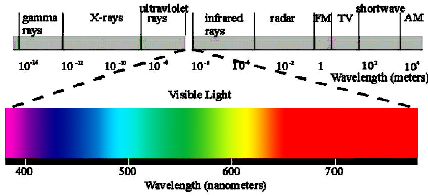Light has been modeled in many ways but the
for the colour theory of light it is easiest to use the wave model.
Like any wave, light is described by its wavelength and intensity.
Our eyes can see light in a wave length range (spectrum) of
approximately 400nm to 700nm and over a very wide intensity range.
For new we shall ignore intensity because it does not affect the
colour of light as long as the light is bright to be visible.
 |
In that range of 400nm to 700nm we can assign a colour to
each wavelength based purely on observation. A laser emitting
light at 632nm appears red and we define 632nm to be the
wavelength corresponding on red. We also observe that the
absence of light is perceived as black and that light with a
mixture of wavelength stretching through the whole visible
spectrum is perceived as white. |
Beyond these experimental observations the colour theory of light
really does not offer any reason why light with a wavelength of
632nm appears red, but at least the model can be used in many
applications such as television, printing, etc. All these
applications use one of two standard methods to create all the
colours without having to use more than three primary sources or
filters. Follow the links for an explanation of the additive and
subtractive colour system.



